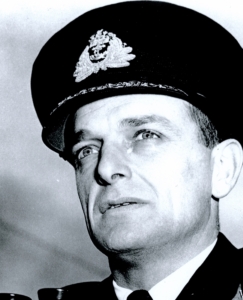Rear Admiral Antony Storrs:
Antony Storrs did not expect to survive D-Day.
The Canadian naval officer who led a critical minesweeping operation to literally clear the way for the Allied invasion of Normandy on 06 June, 1944, later related to his son that he never thought he’d live through the dangerous assignment. “He figured it would be a one-way trip and that the chances of coming out alive were fairly slim,” Andrew Storrs recollects his father telling him.
Storrs was the senior officer of the 31st Minesweeping Flotilla, a Canadian naval unit that cleared the waters before the Americans landed at Utah and Omaha beaches on D-Day. As the Flotilla leader, he was keenly aware of doubts that had been expressed about the Royal Canadian Navy’s competence earlier in the war. But he reportedly trained his crews so thoroughly between March and May 1944 that the British were finally forced to concede that the Canadians were “efficient, keen and competent.”
Although minesweepers normally withdrew when they came under attack, Storrs told his ships to hold fast in their formation, even while under bombardment. The operation demanded superb seamanship skills, as Storrs led his ships close to then German guns under cover of darkness in a strong cross-tide and in poor weather.
Storrs’ tremendous ship-handling skills, patience and even temper, together with the coolness and keen judgement he displayed in the execution of his complex task, played a significant part in the success of Operation Neptune, the naval contribution to the invasion.
Antony Hubert Gleadows Storrs was born in 1907 in Overton, UK. His parents died before he was 15, while the family was living in Rhodesia (now Zimbabwe). He returned home to England to go to Weymouth College, then trained in the merchant navy school ship HMS Worcester.
He later signed on to serve aboard the William Mitchell, one of the last three-masted sailing ships in the British commercial fleet, and circumnavigated the globe. During much of the 1930s, he was employed as a maritime customs officer for the Chinese government, patrolling the coast for opium smugglers and contraband. He left Foo Chow, where he was stationed when the Japanese invaded, fleeing to Shanghai with his wife, Joy, and managing to catch the last blockade-running vessel out.
Arriving in Victoria, BC, in November 1940, the 33-year-old master mariner joined the volunteer reserve of the Royal Canadian Navy. Early in 1941, he was appointed in command of the minesweeper HMCS ARMENTIERES at Esquimalt, and in October 1941, became commanding officer of the corvette HMCS DAWSON. In June 1943, Storrs went to the destroyer HMCS GATINEAU, and later commanded the corvette HMCS DRUMHELLER and the minesweeper HMCS CARAQUET. He was promoted to the acting rank of Commander in February, 1944.
Shortly afterwards, Storrs became Senior Officer of the 31st Minesweeping Flotilla, which played such an important role in preparing the hazardous channels to the Normandy beachhead. As the commander not only of CARAQUET but of a flotilla of seven ships, Admiral Storrs was able to keep calm under extreme pressure and make important strategic decisions in the face of grave danger. Once, when a magnetically sensitive mine was dragged up to his ship while a cable was being retracted, he had the presence of mind to order that the gear be loosened and the ship moved forward at speed. The maneuver gained the ship just enough distance to avoid serious damage when the mine exploded.
For outstanding service while Senior Officer of the minesweeping flotilla, Commander Storrs (later Rear Admiral Storrs) was awarded the Distinguished Service Cross (DSC), a bar to the DSC, the United States Legion of Merit, the French Croix de la Legion d’Honneur and the Croix de Guerre avec Palme.
Antony Storrs returned to Canada at the close of the war and fulfilled various naval roles, including as commanding officer of the naval air station at Shearwater, Nova Scotia, and senior officer of the destroyer HMCS NOOTKA and the aircraft carrier HMCS MAGNIFICENT. He was director of the National Defence College in Kingston for four years before leaving the Navy in 1962.
He died in Victoria on 09 August, 2002.
 CFB Esquimalt Naval and Military Museum
CFB Esquimalt Naval and Military Museum CFB Esquimalt Naval and Military Museum
CFB Esquimalt Naval and Military Museum
 CFB Esquimalt Naval and Military Museum
CFB Esquimalt Naval and Military Museum CFB Esquimalt Naval and Military Museum
CFB Esquimalt Naval and Military Museum CFB Esquimalt Naval and Military Museum
CFB Esquimalt Naval and Military Museum CFB Esquimalt Naval and Military Museum
CFB Esquimalt Naval and Military Museum CFB Esquimalt Naval and Military Museum
CFB Esquimalt Naval and Military Museum CFB Esquimalt Naval and Military Museum
CFB Esquimalt Naval and Military Museum
